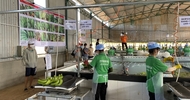Financial Express | May 08, 2010
Huma Siddiqui
New Delhi: India should look at Latin American countries to keep its food security intact. With little or no investment in the agriculture sector, it is estimated that 45% of Indian farmers want to quit farming—supply-side constraints have been a major cause for concern.
Add to that rapidly falling water tables in North India – India’s bread basket, and erratic monsoons from climate change leading to domestic food output falling short of demand, repeatedly in the future.
Talking to FE, Dave Ramaswamy, partner, Allied Ventures, a Buenos Aires-based company, said that, “Latin America can meet India’s food needs, a place where agriculture commands the status of IT in India, with the best brains and fortunes in that sector. Indian companies should join US, European companies who have realized this, and participate in the agri value chain there – investing in contract farming to agro-inputs to food processing to logistics.”
Adding, “Latin America price arbitrage exists in hi-quality farmland – prices ranging from $2000 to $3000 per acre in Uruguay and Paraguay, for ready to farm properties.”
According to senior officials who requested anonymity, “Our food security concerns are immediate. The other option that the country has is increasing the acreage under critical crops, however, there is little scope for this and increasing acreage, especially under pulses and oilseeds, which are critical for us, can only be done at the cost of other crops. Not a win-win scenario again. Besides, it would be difficult to maintain status-quo in net cultivated area due to strains from climate change, water shortages and industrialization.
Since 2006, more than 20 million hectares of agricultural land, an area equivalent to total French agricultural land mass or one-fifth of the total European Union land mass has been taken on lease by several nations. Most of these deals have been done in African, Latin American & East-Asian nations. These partnerships have predominantly been triggered by the tightening world food markets.
In Indian context too, this model, it believed to be the most workable solution. And it would be win-win scenario for the host nations, especially those in the African as well as the LaTAm– as the scope of increasing acreage and also crop productivity is immense in these regions.
FICCI has independently organized a two day business forum on contractual farming from May 6-7 in New Delhi where senior officials from the ministry of external affairs and ministry of agriculture alongwith several envoys discussed opportunities available in contractual farming.
According to Vivek Katju, secretary (West), MEA, “there is immense scope for collaboration between businesses of the India and the LAC region in beefing up India's food security and in areas relating to development of agriculture and agricultural processing.”
A FICCI-Deloitte Paper on ‘India and Latin America & Caribbean (LAC): Business Environment and Opportunities for Collaboration”, indicates that with climate changes wreaking havoc in the agriculture output, India and LAC could synergise and complement each other to meet the growing food crisis.
“In India, consumption is growing while the land is diminishing but here in Latin America we don’t have any such land-shortage problems,” R Viswanathan, India’s ambassador to Argentina, Uruguay and Paraguay, who has been pushing for Indian companies to set up shop in the region told FE.
According to Vishwanathan, in Argentina, rather in LatAm they don’t plough the land now. They practise what is called Direct Seeding (siembre directa) which means they don’t prepare the land with ploughing after the previous harvest. They let the residue from the previous harvest rot and become manure.
Farming in Argentina is done on a large scale, is technology-driven and globally competitive. It is done commercially, scientifically and professionally. The farmers consider 2,000ha as the minimum land holding necessary to do cultivation on their own.
When they have less, or when they don’t want to dirty their hands, they rent out their land to companies and individuals who do professional cultivation on a large scale.












